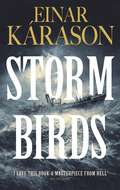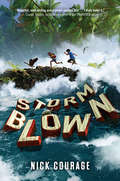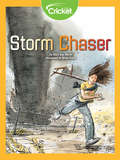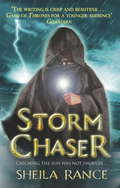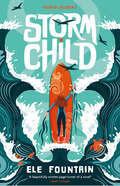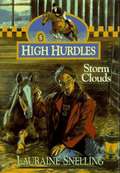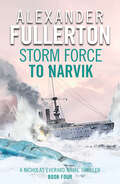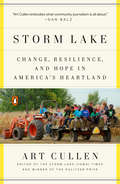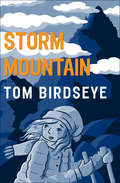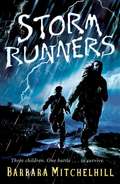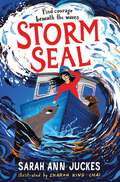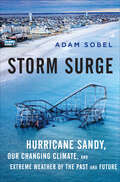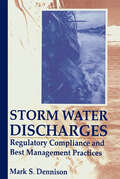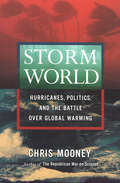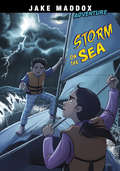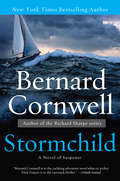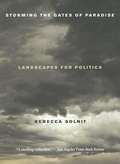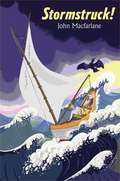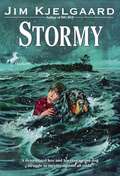- Table View
- List View
Storm Birds
by Einar Karason"This gripping novel is as good at describing the magnificent seascapes and the unforgiving elements as it is at examining the inner lives of the besieged crew, toiling ceaselessly against implacable nature" -Financial Times BOOKS OF THE YEAR"Gripping and Exciting" The Sunday Times BOOKS OF THE YEARIn February 1959, several Icelandic trawlers were caught in a storm off Newfoundland's Grand Banks. What happened there is the inspiration for this novel. Not since The Perfect Storm has there been a book which captures the sheer drama and terror of a crisis at sea. Karason is an exceptional storyteller, an Icelandic Erskine Caldwell or William Faulkner.The side trawler Mafurinn is hit by a major storm just as they prepare to turn for home. Thirty-two men aboard, and a hold full of redfish. The sea is cold enough to kill a man in minutes, and the trawler quickly ices up in the biting frost and violent tempest. The heavy icing weighs down the already fully laden craft, which is pummelled by one breaker after another - and here, out on the open sea, there is no exit route. Distress signals from other ships in the same circumstance and be heard from the fishing grounds around them. It is a battle of life and death.Translated from the Icelandic by Quentin Bates
Storm Birds
by Einar Karason"This gripping novel is as good at describing the magnificent seascapes and the unforgiving elements as it is at examining the inner lives of the besieged crew, toiling ceaselessly against implacable nature" -Financial Times BOOKS OF THE YEAR"Gripping and Exciting" The Sunday Times BOOKS OF THE YEARIn February 1959, several Icelandic trawlers were caught in a storm off Newfoundland's Grand Banks. What happened there is the inspiration for this novel. Not since The Perfect Storm has there been a book which captures the sheer drama and terror of a crisis at sea. Karason is an exceptional storyteller, an Icelandic Erskine Caldwell or William Faulkner.The side trawler Mafurinn is hit by a major storm just as they prepare to turn for home. Thirty-two men aboard, and a hold full of redfish. The sea is cold enough to kill a man in minutes, and the trawler quickly ices up in the biting frost and violent tempest. The heavy icing weighs down the already fully laden craft, which is pummelled by one breaker after another - and here, out on the open sea, there is no exit route. Distress signals from other ships in the same circumstance and be heard from the fishing grounds around them. It is a battle of life and death.Translated from the Icelandic by Quentin Bates
Storm Blown (Fountas & Pinnell LLI Blue)
by Nick Courage"Beautiful, vivid writing and a power-packed plot . . . I truly loved it." --Lauren Tarshis, bestselling author of the I SURVIVED seriesA major hurricane is raging across the southern United States, and two unsuspecting kids are about to have the adventure of a lifetime! Perfect for kids who love high-stakes plots and natural disaster movies, and anyone interested in extreme weather!A little rain and wind don't worry Alejo--they're just part of life at the beach. As his padrino says, as long as there are birds in the waves, it's safe. When people start evacuating, though, Alejo realizes things might be worse than he thought. And they are. A hurricane is headed straight for Puerto Rico.Emily's brother, Elliot, has been really sick. He can't go outside their New Orleans home, so Emily decides to have an adventure for him. She's on a secret mission to the tiny island Elliot loves. She's not expecting to meet up with an injured goose or a shy turtle. And nothing has prepared her for Megastorm Valerie. Soon Alejo and Emily will be in Valerie's deadly path. Who will survive?
Storm Chaser
by Mary Kay MorelEmily is excited to chase storms with her father, a meteorologist. When they finally find a tornado to study, though, they get stuck in its path! Emily must think fast and remember all the tornado safety tips she learned. Will she and her dad be able to safely ride out the storm?
Storm Chaser
by Mike Olbinski&“Olbinski chases storms . . . capturing lightning, tornadoes and dramatic cloud formations in images that convey the awesome power and beauty of nature.&” —International Business Times The storms that cross the Great Plains of North America each spring are some of nature&’s most spectacular. They can also be some of the most dangerous. Most people who live in areas susceptible to these storms keep a close eye on the weather reports and take cover or evacuate when one is on the way. Storm chasers keep an even closer eye on the weather data, but for a different reason: they don&’t run away when they see a storm approaching, they follow it! Professional photographer and Emmy Award winner, Mike Olbinski has chased storms throughout his native Arizona, as well as even further afield, including Texas, Oklahoma, Kansas, and Colorado. Whether he&’s photographing lightning, tornadoes or even cloud formations, his remarkable images are able to convey nature in its most dramatic and impressive forms. With over 100 stunning colour photographs, this book brings together some of Mike&’s most breathtaking images from the past five years as he describes his love of the open road and the thrill of capturing the perfect storm on film. &“These pictures are truly fascinating; they show just how small we are and how little control we have over the environment and that these storms can pack a wallop. For fans of weather and spectacular photos, this is the book for you.&” —San Francisco Book Review (5-star review) &“A striking series of breath-taking pictures of nature lashing out from apocalyptic skies.&” —Daily Mail Online
Storm Chaser
by Sheila RanceSilk whispers. Clouds gather. A storm is coming. Many years ago, a storm brought Maia to the cliffs. Now she is Sun Catcher in the land of Khandar, but when her father, Tareth, needs silk, Maia must go back to the clifftops she once fled. Danger awaits her every step of the way: assassins, thought-stealers, the Marsh Lord - all greedy for her power. And Razek, who deserted his people to follow her, must pay a high price as he tries to bend wind and rain to his will - and chase away the storms.Film rights to the trilogy have now been optioned.
Storm Chasing Challenges
by Scott ForesmanRead several types of literature, including poetry, drama and prose, Use direct text examples to support ideas about the reading, Recognize themes within a story, Develop an individual writing style, Include correct punctuation, capitalization and grammar in writing, Conduct course-related research using the text and outside sources, Adapt writing style to speak to a specific audience.
Storm Child
by Ele FountainAn exciting, thought-provoking novel about globalization, climate change and finding your place in a changing worldMaya lives in a remote house on the cost, spending her time hanging out with her friends and surfing, while her mother bakes for the local café and her father works as a fisherman. They lead a simple life and though they often struggle to get by financially they are happy and secure. But Maya&’s world is about to be upended. When her dad's fishing boat sinks in a ferocious storm and he ends up in hospital fighting for his life the famiy lose their only means of earning money and life takes on a perilous turn. Desperate for a change Maya's parents make the decision to start over by moving to an island in the Pacific – a place they are sure is paradise.Life in their new home starts to take on an order and while Maya misses her friends she finds a new companion in a girl who lives close by. Maya&’s parents, however, seem to be unable to make a true commitment to their new life and it takes Maya to point out the obvious – that the grass is not always greener on the other side of the fence and making a change doesn't always make a difference.As Maya begins to realise that paradise is not always what it seems, can she bring her family back home again?
Storm Clouds (High Hurdles #5)
by Lauraine SnellingDJ hopes to survive the stressful month before her mother's wedding. An invitation to spend a week at her father's horse ranch seems a perfect escape, but will DJ's attitude ruin everything?
Storm Force to Narvik: The Nicholas Everard World War Ii Saga Book 1 (Nicholas Everard Naval Thrillers #1)
by Alexander FullertonEverard is returns in a new global conflict.British Captain Nick Everard's destroyer is crippled by Nazi gunfire in the German invasion of Norway. Nothing seems able to stop the advance across Europe and the Royal Navy is in a tight situation.Desperately attempting to repair his ship hidden in a remote fjord, Everard is unaware that his son is part of an Allied naval flotilla converging on Norway, and the two are fated to join forces in a deadly arctic battle.Moving into a new and explosive phase of Everard’s career, Storm Force to Narvik takes us deep into the action and danger of the Second World War.
Storm Lake: A Chronicle of Change, Resilience, and Hope from a Heartland Newspaper
by Art CullenFrom a 2017 Pulitzer-winning newspaperman, an unsentimental ode to America's heartland as seen in small-town Iowa--a story of reinvention and resilience, environmental and economic struggle, and surprising diversity and hope.When The Storm Lake Times, a tiny Iowa twice-weekly, won a Pulitzer Prize for taking on big corporate agri-industry for poisoning the local rivers and lake, it was a coup on many counts: a strike for the well being of a rural community; a triumph for that endangered species, a family-run rural news weekly; and a salute to the special talents of a fierce and formidable native son, Art Cullen. In this candid and timely book, Cullen describes how the rural prairies have changed dramatically over his career, as seen from the vantage point of a farming and meatpacking town of 15,000 in Northwest Iowa. Politics, agriculture, the environment, and immigration are all themes in Storm Lake, a chronicle of a resilient newspaper, as much a survivor as its town. Storm Lake's people are the book's heart: the family that swam the Mekong River to find Storm Lake; the Latina with a baby who wonders if she'll be deported from the only home she has known; the farmer who watches markets in real time and tries to manage within a relentless agriculture supply chain that seeks efficiency for cheaper pork, prepared foods, and ethanol. Storm Lake may be a community in flux, occasionally in crisis (farming isn't for the faint hearted), but one that's not disappearing--in fact, its population is growing with immigrants from Laos, Mexico, and elsewhere. Thirty languages are now spoken there, and soccer is more popular than football.Iowa plays an outsize role in national politics. Iowa introduced Barack Obama and voted bigly for Donald Trump. Is the state leaning blue, red, or purple in the lead-up to 2020? Is it a bellwether for America? A nostalgic mirage from The Music Man, or a harbinger of America's future? Cullen's answer is complicated and honest--but with optimism and the stubbornness that is still the state's, and his, dominant quality.
Storm Mountain
by Tom BirdseyeCat Taylor is furious when her cousin steals her father&’s ashes to scatter on the mountain—but when they get caught in a blizzard, can the two work together to survive? Cat Taylor&’s father and uncle, a famous search-and-rescue team, died on Storm Mountain two years ago, and Cat and her mother still can&’t seem to move on. When her mom goes away on business for the weekend, Cat thinks she has the house to herself—until her cousin Ty suddenly shows up at her door, claiming his dad visited him in a dream and told him to scatter the two brothers&’ ashes at the mountain&’s summit. Cat refuses; how can Ty ask her to let go of her dad? But when she wakes up the next morning, Cat discovers that Ty has gone to Storm Mountain—and he took her father&’s ashes with him. Determined to stop Ty before he does something crazy, Cat races up the mountain after him. But when a huge snowstorm rolls in and traps them, Cat and Ty realize they could be in more danger than they ever imagined.
Storm Rescue: Sunita (Vet Volunteers #6)
by Laurie Halse AndersonSunita Patel is book-smart and good with cats. When a hurricane approaches, Sunita realizes that Lucy, a diabetic cat with a broken leg, is in danger, along with her owner, Mrs. Clark. When the vets are called out on emergency, the evacuation starts. Will Sunita be able to save Lucy or will she be a scaredy-cat?
Storm Rising
by Marilyn SingerSeventeen-year-old Storm, lonely, lost, and going nowhere, is drawn to a gentle older woman who possesses unusual powers, and as love develops between them, Storm experiences the beginnings of confidence, suffering, and a promise of a new start to his life.
Storm Runners
by Barbara MitchelhillTwo girls find themselves on a remote Scottish island with a laboratory of evil scientists who intend to wreak havoc with the weather. They must escape and get the evidence back to Edinburgh before the scientists become unstoppable.
Storm Seal: A seaside story of family and hope
by Sarah Ann JuckesFind your voice in the waves in a heartfelt and hopeful story of family, friendship, and learning to accept change from the critically-acclaimed partnership, Sarah Ann Juckes and Sharon King-Chai, selected for Waterstones Children's Book of the Month with The Night Animals. Martha was raised on her nana&’s stories. Even if no one else believes them, Martha knows that they&’re magic. Now those stories are helping Martha hold things together when everything around her is falling apart – out-of-towners moving into her family&’s old house, her nana&’s mysterious illness, and the tourists flooding the town who don&’t seem to care about the sea or the animals it&’s home to. But Martha has found one creature who understands – a black seal pup that seems to appear whenever Martha needs it most. Could she be the key to fixing everything that's wrong, or will Martha need to fight her way through the storm herself? Illustrated by the award-winning Sharon King-Chai, Sarah Ann Juckes&’ emotional novel follows a young girl trying to protect her family and her community, who must learn that not all changes are bad. For fans of The Last Bear and Julia and the Shark.Praise for Sarah Ann Juckes &‘Will break your heart and mend it together again&’ ― Piers Torday on The Hunt for the Nightingale &‘Full of hope, beauty & ultimately a healing song to nature&’ ― Hannah Gold on The Hunt for the Nightingale &‘An incredibly moving story of feeling lost and finding your way again&’ ― Lisa Thompson on The Hunt for the Nightingale 'An iridescent story that shines with hope and love' ― Katya Balen on The Night Animals 'A beautiful story about ghosts, friendship, and the courage it takes to ask for help' ― Emma Carroll on The Night Animals
Storm Surge: Hurricane Sandy, Our Changing Climate, and Extreme Weather of the Past and Future
by Adam SobelWas Sandy a freak of nature, or the new normal?On October 29, 2012, Hurricane Sandy reached the shores of the northeastern United States to become one of the most destructive storms in history. But was Sandy a freak event, or should we have been better prepared for it? Was it a harbinger of things to come as the climate warms? In this fascinating and accessible work of popular science, atmospheric scientist and Columbia University professor Adam Sobel addresses these questions, combining his deep knowledge of the climate with his firsthand experience of the event itself.Sobel explains the remarkable atmospheric conditions that gave birth to Sandy and determined its path. He gives us insight into the science that led to the accurate forecasts of the storm from genesis to landfall, as well as an understanding of why our meteorological vocabulary failed our leaders in warning us about this unprecedented weather system—part hurricane, part winter-type nor'easter, fully deserving of the title "Superstorm."Storm Surge brings together the melting glaciers, the warming oceans, and a broad historical perspective to explain how our changing climate and developing coastlines are making New York and other cities more vulnerable. Engaging, informative, and timely, Sobel's book provokes us to think differently about how we can better prepare for the storms in our future.
Storm Water Discharges: Regulatory Compliance and Best Management Practices
by Mark S. DennisonFilled with tables, checklists, worksheets, and sample plans, Storm Water Discharges is a unique, nontechnical guide to the full spectrum of storm water issues. Written in a language accessible to everyone, this guide offers a practical, nuts-and-bolts approach to compliance with EPA's complex storm water discharge requirements. In addition to a st
Storm World: Hurricanes, Politics, and the Battle Over Global Warming
by Chris MooneyAn investigation into climate change and increasingly dangerous hurricanes from the New York Times–bestselling author of The Republican War on Science. A leading science journalist delves into a red-hot debate in meteorology: whether the increasing ferocity of hurricanes is connected to global warming. In the wake of Katrina, Chris Mooney follows the careers of leading scientists on either side of the argument through the 2006 hurricane season, tracing how the media, special interests, politics, and the weather itself have skewed and amplified what was already a fraught scientific debate. As Mooney puts it: &“Scientists, like hurricanes, do extraordinary things at high wind speeds.&” Mooney—a New Orleans native, host of the Point of Inquiry podcast, and author of The Republican Brain—has written &“a well-researched, nuanced book&” that closely examines whether we as a society should be held responsible for making hurricanes even bigger monsters than they already are (The New York Times). &“Mooney serves his readers as both an empiricist who gathers data and an analyst who puts it into context. The result is an important book, whose author succeeds admirably in both his roles.&” —The Plain Dealer &“Engaging and readable . . . Mooney catches real science in the act and, in so doing, weaves a story as intriguing as it is important.&” —Los Angeles Times Book Review &“Mooney has hit upon an important and controversial topic, and attacks it with vigor.&” —The Boston Globe &“An absorbing, informed account of the politics behind a pressing contemporary controversy.&” —Kirkus Reviews
Storm is Coming! (Journeys)
by Heather TekavecAs the news of an approaching storm travels across the farm, the animals fear the worst. Who is the scary creature called Storm? Full-color illustrations.
Storm on the Sea (Jake Maddox Adventure)
by Jake MaddoxIn the wake of great loss, Aisha has found comfort in sailing. And it seems the rest of her family has found comfort in pretending nothing’s changed. Frustrated with their silence, Aisha escapes one night on her family’s sail boat. Her brother, Sai, catches up to her, but before he can convince her to come back, a storm rolls in. Aisha and Sai must work through their feelings and trust in each other to survive the storm.
Stormchild
by Bernard CornwellTragedy has decimated Tim Blackburn's safe and comfortable existence. Having already lost a son in a terrorist attack, he must now cope with the death of his beloved wife, killed in a mysterious explosion at sea. And all that remains of his destroyed family is his missing daughter Nicole, last seen in the company of Caspar von Rellsteb--the mad, charismatic leader of the shadowy environmental activist group called Genesis--who keeps an iron-fisted hold over his fanatically dedicated followers. Determined to free Nicole from the crazed, self-proclaimed "protector of the planet," Tim sets sail aboard the sloop Stormchild, with the beautiful, story-hungry journalist Jackie Potten. But their hunt for the hidden lair of Genesis is leading them into dangerous and terrifying waters--and the darkness that waits for Tim Blackburn on the far side of the world could destroy both his sanity and his soul.
Storming the Gates of Paradise: Landscapes for Politics
by Rebecca SolnitStorming the Gates of Paradise gathers together nearly forty essays whose common ground is a concern with place, geography, land, environment, and an interest in reading them politically-- and in understanding politics through place.
Stormstruck!
by John MacfarlaneBelieving his parents are going to euthanize Pogo, a beloved golden Labrador that had belonged to his deceased brother, twelve-year-old Sam sets sail with the dog and gets caught in a terrible storm along with Magnus, a hermit, and his pet tern, Fuego, whom they meet on an island.
Stormy
by Jim KjelgaardAllan Marley and his father have lived together in the untamed wilderness of the Beaver Flowage all their lives. But when Mr. Marley is jailed because of a bitter feud, Allan suddenly finds himself on his own. Then he meets Stormy, an outlaw dog who has been accused of turning on his owner. Allan knows that the big black retriever has been mistreated, and he works hard to win the noble dog's trust and affection. As allies, Allan and Stormy overcome every danger they encounter in the unpredictable wilderness... but can their bond protect Allan from the viciousness of his father's human enemies?
